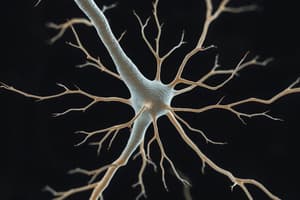Podcast
Questions and Answers
What is the primary role of receptors in the nervous system?
What is the primary role of receptors in the nervous system?
- To detect stimuli and send electrical impulses to the CNS (correct)
- To inhibit neuronal communication
- To coordinate responses without CNS involvement
- To send impulses to muscles directly
Which components make up the central nervous system?
Which components make up the central nervous system?
- Spinal cord and peripheral nerves
- Brain and spinal cord (correct)
- Muscles and sensory neurons
- Brain, heart, and spinal cord
In the response pathway, what occurs after the sensory neuron sends impulses to the CNS?
In the response pathway, what occurs after the sensory neuron sends impulses to the CNS?
- The stimulus is ignored
- Muscles overreact to the stimulus
- Electrical impulses are sent back to the receptors
- The CNS coordinates an appropriate response (correct)
What triggers the response in the reflex arc pathway?
What triggers the response in the reflex arc pathway?
Which of the following correctly describes the sequence of events from stimulus to response?
Which of the following correctly describes the sequence of events from stimulus to response?
What is the first step of a reflex arc process?
What is the first step of a reflex arc process?
Which part of the reflex arc is responsible for transmitting the electrical impulse from the CNS to the muscle?
Which part of the reflex arc is responsible for transmitting the electrical impulse from the CNS to the muscle?
What happens at the synapse in a reflex arc?
What happens at the synapse in a reflex arc?
How does the electrical impulse travel in the sensory neurone of a reflex arc?
How does the electrical impulse travel in the sensory neurone of a reflex arc?
What is the role of the effector in a reflex arc?
What is the role of the effector in a reflex arc?
Flashcards are hidden until you start studying
Study Notes
Nervous System Process Overview
- Stimulus triggers a response via receptors, the central nervous system (CNS), and effectors.
Central Nervous System (CNS)
- The CNS consists of the brain and spinal cord, and associated nerves.
Receptors and their Function
- Receptors detect stimuli and transmit electrical impulses to the CNS via neurons.
Example of a Response Pathway
- A heat stimulus on the finger (receptor) results in a muscle contraction (effector response). The pathway involves a sensory neuron, CNS processing, and a muscle effector.
Reflex Arc Components and Function
- Sensory neurons receive stimuli, relay neurons transmit impulses across synapses, and effectors (muscles) cause the response. Chemical diffusion plays a key role at synapses.
Reflex Arc Step-by-step
- Stimulus detection by receptors initiates the process.
- Sensory neurons transmit electrical impulses to the CNS.
- Synaptic transmission involves chemical diffusion to relay neurons.
- Relay neurons relay the impulse to another synapse.
- Chemical release triggers impulses in motor neurons.
- Motor neurons transmit impulses to effectors.
- Effectors (e.g., muscles) contract, producing the response (e.g., pulling away from heat).
Studying That Suits You
Use AI to generate personalized quizzes and flashcards to suit your learning preferences.




